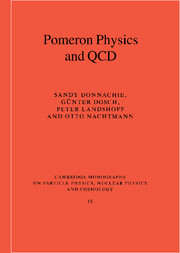Book contents
- Frontmatter
- Contents
- Preface
- 1 Properties of the S-matrix
- 2 Regge poles
- 3 Introduction to soft hadronic processes
- 4 Duality
- 5 Photon-induced processes
- 6 QCD: perturbative and nonperturbative
- 7 Hard processes
- 8 Soft diffraction and vacuum structure
- 9 The dipole approach
- 10 Questions for the future
- Appendix A Sommerfeld-Watson transform
- Appendix B The group SU(3)
- Appendix C Feynman rules of QCD
- Appendix D Pion-nucleon amplitudes
- Appendix E The density matrix of vector mesons
- References
- Index
7 - Hard processes
Published online by Cambridge University Press: 19 August 2009
- Frontmatter
- Contents
- Preface
- 1 Properties of the S-matrix
- 2 Regge poles
- 3 Introduction to soft hadronic processes
- 4 Duality
- 5 Photon-induced processes
- 6 QCD: perturbative and nonperturbative
- 7 Hard processes
- 8 Soft diffraction and vacuum structure
- 9 The dipole approach
- 10 Questions for the future
- Appendix A Sommerfeld-Watson transform
- Appendix B The group SU(3)
- Appendix C Feynman rules of QCD
- Appendix D Pion-nucleon amplitudes
- Appendix E The density matrix of vector mesons
- References
- Index
Summary
Modern high-energy physics may be said to have begun with the deep-inelastic electron-scattering experiments at the Stanford Linear Accelerator in the late 1960s. In these experiments, an electron is made to collide with a proton; the electron radiates a virtual photon γ*, which strikes the proton and breaks it up, as is shown in figure 7.1. Similar experiments have since been performed, at progressively higher energies. Some of these instead have been with muon beams, and there have also been related experiments with neutrino beams. The highest energy achieved so far has been at the electron-proton collider HERA in Hamburg.
In this chapter we describe the phenomenology and the theory of deep-inelastic lepton scattering. The theory relates it to various other semi-hard processes and brings together perturbative QCD and Regge ideas.
Deep-inelastic lepton scattering
Figure 7.1 describes deep-inelastic electron or muon scattering. We see that, effectively, it explores the scattering of the virtual photon on the proton, so as to form a system X of hadrons. Factoring off a γ* flux from figure 7.1, we may identify the remaining factor as the γ*p cross section. Figure 7.1 is well-defined but, as one may adopt different definitions of a γ* flux, the precise definition of σγ*p is a matter of convention, except for the case of real photons; see (7.6). Whatever definition is used, the optical theorem relates the total γ*p cross section, summed over X, to the imaginary part of the forward virtual-Compton amplitude; see figure 7.2.
- Type
- Chapter
- Information
- Pomeron Physics and QCD , pp. 160 - 218Publisher: Cambridge University PressPrint publication year: 2002

